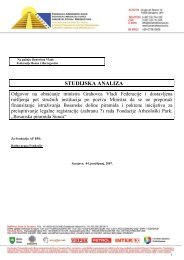The Complete Guide To Mysterious Beings - Galaksija
The Complete Guide To Mysterious Beings - Galaksija
The Complete Guide To Mysterious Beings - Galaksija
You also want an ePaper? Increase the reach of your titles
YUMPU automatically turns print PDFs into web optimized ePapers that Google loves.
witnesses who had claimed to have glimpsed old ”Big Foot.” In his treks about the state he<br />
discovered a number of the classic foot tracks and dutifully made plaster casts of them. He<br />
established the Abominable Snowmen Club of America in the early 1960s, and spent all of his spare<br />
time and money traveling and investigating new cases.<br />
On October 20, 1967, Patterson and Bob Gimlin were exploring the ”Big Foot” country northeast of<br />
Eureka, California on horseback. <strong>The</strong>y rounded a bend and came upon a small creek. On the other<br />
side, about a hundred feet away, there stood a huge, furry creature. At first they thought it was a<br />
bear but then it stood upright and started to walk away. <strong>The</strong>ir horses became terrified and threw<br />
them. Patterson managed to grab his loaded movie camera and he ran after the animal. It was a<br />
female. He excitedly cranked off several feet of film while she strolled into the brush and<br />
disappeared.<br />
”She was about seven feet tall, and from examination of her tracks later, we estimated her to weigh<br />
in the neighborhood of three hundred pounds,” Patterson said. ”She was covered with short, shiny<br />
black hair, even on her big, droopy breasts. She seemed to have a sort of peak on the back of her<br />
head, but whether this was more hair or not I don't know.<br />
”Anyway, hair came right down her forehead to meet her eyebrows, if she had any; and it came up<br />
to just under her cheekbones. And she had no neck. What I mean is that the bottom of her head just<br />
seemed to broaden out onto her big muscular shoulders.<br />
”She walked like a man – a big man in a hurry... the soles of her feet were definitely light in color.”<br />
Among those who viewed the film was Dr. John R. Napier, Director of Primate Biology at the<br />
Smithsonian Institute in Washington, D.C. He later stated, ”I observed nothing that, on scientific<br />
grounds, would point conclusively to a hoax. I am satisfied that the walk of the creature shown in<br />
the film was consistent with the bipedal striding gait of a man.<br />
”<strong>The</strong> bodily proportions of the creature, as far as could be seen, appeared to be within the normal<br />
limits for man. <strong>The</strong> appearance of the high crest on top of the skull is unknown, but given a creature<br />
as heavily built as the subject, such a bio-chemical adaption to an exclusively fibrous raw vegetable<br />
diet is not impossible.”<br />
But Roger Patterson had not solved the mystery. He had only compounded it.<br />
Now we had a seemingly authentic movie of an ABSM female. All we needed to clinch our case<br />
was a body of one of the creatures. <strong>The</strong> final amazing chapter to this epic was written in December<br />
1968, when a body turned up and was examined by Ivan Sanderson and Dr. Bernard Heuvelmans,<br />
the great European authority. This should have settled the matter once and for all. But it didn't. <strong>The</strong><br />
discovery was given a big play in the press but when reporters went to view the remains they<br />
discovered only a wax replica. So new stories were published denouncing the whole affair as a<br />
hoax. Could two experienced authorities like Sanderson and Heuvelmans have made such a<br />
mistake?<br />
On May 3, 1967, the corpus delecti went on exhibit in a refrigerated van attached to a traveling<br />
show in the Midwest. Thousands of people paid thirty-five cents for the privilege of trooping<br />
through the van that season and the next. <strong>The</strong> barker outside made no effort to identify the creature,<br />
merely classifying it as another of nature's mysteries. <strong>The</strong> body was deeply entombed in a huge<br />
cake of ice with soft lights focused on it. People entered the van not knowing what they were going<br />
to see and left not knowing what they had seen. Finally, a herpetologist from Milwaukee,<br />
Wisconsin, Mr. Terry Cullen, paid his thirty-five cents, wandered into the exhibit, and then rushed<br />
to a telephone to call Ivan T. Sanderson long distance. Sanderson, long hardened from constant<br />
exposure to hoaxes and the almost endless nonsense that revolved around the study of monsters,<br />
was wary at first. But Cullen's credentials were respectable, and his description of the frozen animal<br />
was detailed enough to excite his interest.<br />
In December 1968 Sanderson and Heuvelmans descended upon the little village of Rolling Stone,<br />
Minnesota, where the refrigerated van was kept during the winter under the care of Frank Hansen.<br />
<strong>The</strong> scientists worked methodically in the freezing cold, setting up lights and cameras to photograph<br />
the cake of ice from all angles, making careful measurements and drawings. <strong>The</strong>y knew that if they<br />
tried to free the body from the ice the decay would be accelerated and the specimen would quickly










